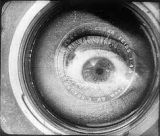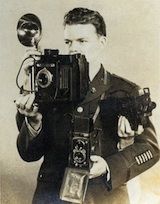- Forum
- General Discussion | Introductions | Off Topic Forum
- Photography General Discussion
- Tips on photographing someone who is wearing glasses?
Tips on photographing someone who is wearing glasses?
-
 Topic Author
Topic Author
- ArtWagner
- Snapobsessed
-
- Canon 5D Mark III
- Followers: 96
- Posts: 313
-
Points:
1767
Post #108313
Should I just have the kid remove her glasses? If I move the flash it might remove the glare but then the light is all screwed up for the rest of the photo?
-

- MLKstudios
- Banned
-
- D800 ;-)
- Followers: 72
- Posts: 4480
-
Points:
2
Post #108337
With flash, you just have to be aware that it causes a reflection when aimed straight on. If possible bounce the light, or raise the ISO so flash isn't needed.
The best way to do an outdoor (available light) portrait is to use the sun as a hair light and a reflector for fill. Then you can see where the light touches.
Matthew
Matthew L Kees
MLK Studios Photography School
www.MLKstudios.com
[email protected]
"Every artist, was once an amateur"
Post #108350
In post you can try to burn the eyes a bit to reduce the glare but really you don't want to mess with the eyes too much. They can be the heart and soul of the image.
“Amateurs worry about equipment, professionals worry about money, masters worry about light, I just make pictures… ” ~ Vernon Trent
-

- Maria21
- Snapobsessed
-
- Canon Rebel XTi
- Followers: 28
- Posts: 452
-
Points:
0
Post #108391
I have found it helpful to have the subject tip their head down just a bit, just enough to pull the chin in & lose the glare off the glasses & the light to bounce off the rim..it's very slight tip & for the most part goes un noticed in the final image.
use a diffuser on your flash if possible
use reflected lighting or natural lighting if possible.
Matthews suggestion works well for glasses with larger lenses, but smaller lenses look like they are falling off the subject....That is when I have the subject tilt their head.
There are probably more but these are what I use most.
Here are some examples of having the subject just tilt their heads a bit
Zerfing's Photographic Imaging
-

- Henry Peach
- Apprentice
-
- I currently use a 5DII or Sony Nex-3 most of the time.
- Followers: 50
- Posts: 2925
-
Points:
16
Post #108462
MLKstudios wrote: ... tilt the glasses down some (by lifting them on the ear).
If I can't move the light I use the above method.
-

- photobod
- Paparazzi
-
- Nikon D800 + D300
- Followers: 563
- Posts: 8907
-
Points:
150
Post #108526
www.dcimages.org.uk
"A good photograph is one that communicate a fact, touches the heart, leaves the viewer a changed person for having seen it. It is, in a word, effective." - Irving Penn
-

- Big Kevin
- Lone Wolf
-
- Nikon D300
- Followers: 19
- Posts: 109
-
Points:
0
-

- MLKstudios
- Banned
-
- D800 ;-)
- Followers: 72
- Posts: 4480
-
Points:
2
Post #108803
But without polarized lighting, a polarized filter isn't going to accomplish much.
HTH
Matthew L Kees
MLK Studios Photography School
www.MLKstudios.com
[email protected]
"Every artist, was once an amateur"
- Forum
- General Discussion | Introductions | Off Topic Forum
- Photography General Discussion
- Tips on photographing someone who is wearing glasses?
Latest Reviews
The Olympus Pen E-P7 is an affordable micro four thirds mirrorless camera with 4K video capabilities, a 20.3MP sensor, and 121 focus points, making it a solid entry-level camera for beginners.
The Panasonic G9 II is a 25.2-megapixel micro four thirds camera with numerous features that make it punch out of its weight class, like 779 AF points, 5.8K video, and weather sealing.
The Fujifilm XT5 is a 40MP mirrorless camera capable of 6.2K video at 30p. With those specs, it’s an ideal choice for photographers needing a camera to pull double duty for imaging and video.
The Canon EOS R100 is an entry-level mirrorless camera introduced in 2023. But just because it’s an entry-level camera doesn’t mean it’s a bare-bones camera. Find out why in this review!
Forum Top Posters
-
1Scotty 8 posts
-
2TCav 6 posts
-
3Ruby Grace 6 posts
-
4Nefarious 3 posts
-
5CharleyL 3 posts
-
6Jim Photo 3 posts
-
7Roger Lang 3 posts
-
8ShutterPal 3 posts
-
9James L 2 posts
-
10Clark Guay 2 posts
Latest Articles
The best photography jobs right now are a mix of tried-and-true gigs like wedding photography and new jobs highlighting AI’s capabilities, travel, and videography.
The Olympus Pen E-P7 is an affordable micro four thirds mirrorless camera with 4K video capabilities, a 20.3MP sensor, and 121 focus points, making it a solid entry-level camera for beginners.
Starting a photography business is one thing; sustaining your business over a long period of time is another. Use the tips in this professional photography guide to build something with longevity!
The Panasonic G9 II is a 25.2-megapixel micro four thirds camera with numerous features that make it punch out of its weight class, like 779 AF points, 5.8K video, and weather sealing.
Cinematic photography is an interesting genre that combines photographic and videographic skills along with effective storytelling techniques. The result? Highly impactful images!
Newborn photography requires skill, the right gear, and a lot of patience. This beginner’s guide discusses critical topics that will help you be more prepared for before, during, and after the shoot.
To fill the frame means to expand the footprint of the subject in your shot. Get in close, zoom in, crop the image, or use other techniques to bring the subject to the forefront.
With these simple yet effective beginner photography tips, you can avoid some of the common mistakes beginners make and get improved results with your images.



















